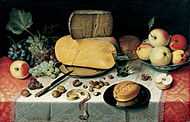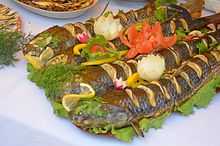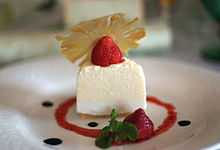Full course dinner
| Part of a series on |
| Meals |
|---|
 |
| Meals |
| Components and courses |
| Related concepts |
A full course dinner is a dinner consisting of multiple dishes, or courses. In its simplest form, it can consist of three or four courses, such as hors d'oeuvre, soup, entrée, main course and dessert.
Form

In formal dining, a full course dinner can consist of 5, 6, 8, 10, 12, or 16 courses, and, in its extreme form, has been known to have twenty-one courses. In these more formalized dining events, the courses are carefully planned to complement each other gastronomically. The courses are smaller and spread out over a long evening, up to three, four or five hours, and follow conventions of menu planning that have been established over many years. Most courses (excluding some light courses such as sorbets) in the most formal full course dinners are usually paired with a different wine, beer, liqueur, or other spirit.
In service à la russe, courses are brought to the table in sequence and only empty plates are set in front of each guest. Courses are served on platters and each person makes a selection from a variety of dishes, and fills his/her own plate. Food presentation is skillfully focused on the platters. A filled plate is never placed in front of a guest because that would imply limited portions. Guests are expected to choose whatever they like and eat as much as they want.

In service à la française, food is served "family-style" with all courses on the table at the same time. Each person serves himself/herself, so that all dishes are not served at their optimum temperatures. Alternatively, buffet style is a variation of the French service where all food is available at the correct temperature, in a serving space other than the dining table. Guests commute to the buffet to be served or sometimes serve themselves, and then carry their plates back to the table.
In American formal dining, each course is served sequentially. Guests are served plates already filled with food in individual portions. Sometimes, guests have an opportunity to choose between vegetarian or meat entrees, but not always. There is no opportunity to request something different, or to ask for more than a single serving. However, portions are usually large. Since there are no platters, food presentation is focused on individual portions, skillfully decorated to look like art, where each plate is a masterpiece.
Cutlery
Table settings can be elaborate. More ostentatious settings sometimes include all silverware and glassware that will be needed for the entire meal, and lay out the silverware so that the outermost tools are used for the dishes appearing earliest on the menu. In this scheme, when diners are served the first course, they can depend on finding the correct implement at the outermost edge of the arrangement.
An alternative scheme arranges the place setting so that only the implements needed for the first one or two courses appear in the table setting. As the dinner progresses and new courses arrive, used implements are removed with the dishes, and new silverware is placed next to the plates. This scheme is commonly used when dinners are offered à la carte, so that the most appropriate implement is selected for a given course. For example, some diners may order clear, thin soups and others may order thick, creamy soups. As each of these soups has its own unique spoon, it would be considered improper and impractical to lay out a spoon that may not be needed or correct.
Example meal
The first class passengers aboard the ill-fated ocean liner R.M.S. Titanic were served a ten course meal:[1]
First Course
- Hors D'Oeuvres
- Oysters
Second Course
Third Course
- Poached Salmon with Mousseline Sauce, Cucumbers
Fourth Course
- Filets Mignon Lili
- Saute of Chicken, Lyonnaise
- Vegetable Marrow Farci
Fifth Course
- Lamb, Mint Sauce
- Roast Duckling, Apple Sauce
- Sirloin of Beef, Chateau Potatoes
- Green Pea
- Creamed Carrots
- Boiled Rice
- Parmentier & Boiled New Potatoes
Sixth Course
- Punch Romaine
Seventh Course
Eighth Course
- Cold Asparagus Vinaigrette
Ninth Course
Tenth Course
- Waldorf Pudding
- Peaches in Chartreuse Jelly
- Chocolate & Vanilla Éclairs
- French Ice Cream
An example of a twenty-one course dinner follows:
- Palate cleanser, or amuse. This may be preceded by a refreshing, lightly alcoholic drink, if the diners are to wait or mingle before being seated.
- Second amuse
- Caviar
- Cold appetizer
- Thick soup
- Thin soup
- Shellfish
- Antipasto
- Pasta (usually short, long pasta being more suited to informal lunches)
- Intermezzo (Sorbet)
- Quail
- Wild mushrooms
- Beef
- Green salad
- Puffed pastry filled with herbed mousse
- Cheese
- Pudding
- Ice cream
- Nuts
- Petit four
- Coffee, liquor (in a home, as opposed to a restaurant, these are properly served in the more relaxed setting of a drawing room or salon, not at the dining table)
Courses such as the above need not be served in strict sequence. Many are well-suited to be served paired with the previous or next course; this also minimises waiting for guests who may choose to have very little of a course for one reason or another.
1 course meal
- Main course
2 course meal
- Main course
- Dessert (fruit salad)
3 course meal
- Appetizer(soup)/Entree/Salad
- Main course
- Dessert/Pudding
4 course meal
- Appetizer (soup)
- Entrée/Salad
- Main course
- Dessert/Pudding
- Assorted Cheeses (usually cheddar)